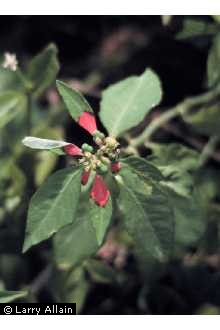Difference between revisions of "Euphorbia heterophylla"
(→Ecology) |
|||
| Line 40: | Line 40: | ||
<!--===Pollination===--> | <!--===Pollination===--> | ||
<!--===Use by animals===--> <!--Herbivory, granivory, insect hosting, etc.--> | <!--===Use by animals===--> <!--Herbivory, granivory, insect hosting, etc.--> | ||
| − | + | ||
| + | ===Diseases and parasites=== | ||
| + | It is a host plant for the false spider mite ''Brevipalpus californicus''.<ref>Childers, C. C., et al. (2003). "Host plants of Brevipalpus californicus, B. obovatus, and B. phoenicis (Acari: Tenuipalpidae) and their potential involvement in the spread of viral diseases vectored by these mites." Experimental & Applied Acarology 30: 29-105.</ref> | ||
==Conservation and Management== | ==Conservation and Management== | ||
Revision as of 09:24, 13 May 2019
Common Names: Fire on the mountain[1]; painted euphorbia; catalina[2]; Fiddler's spurge; Mexican fireplant
| Euphorbia heterophylla | |
|---|---|

| |
| Photo from USDA NRCS Plants Database. | |
| Scientific classification | |
| Kingdom: | Plantae |
| Division: | Magnoliophyta - Flowering plants |
| Class: | Magnoliopsida - Dicots |
| Order: | Euphorbiales |
| Family: | Euphorbiaceae |
| Genus: | Euphorbia |
| Species: | E. heterophylla |
| Binomial name | |
| Euphorbia heterophylla L. | |

| |
| Natural range of Euphorbia heterophylla from USDA NRCS Plants Database. | |
Contents
Taxonomic Notes
Synonym: Poinsettia heterophylla (Linnaeus) Klotzsch & Garcke ex Klotzsch; Poinsettia geniculata Ortega
Description
E. heterophylla is a annual/perennial forb/herb of the Euphorbiaceae fmaily native to North America.[1] It has minute flowers that lack petals within a gland-rimmed and 5-lobed cup. This structure is on top of a leafy stem above white, red, and yellow leaves. Plant overall has milky sap.[3]
Distribution
E. heterophylla is found along the southern United States, from Florida to California, and disjunct in Kentucky. It is also native to Puerto Rico and the U.S. Virgin Islands, and has been introduced to Hawaii and the Pacific Basin.[1]
Ecology
Habitat
E. heterophylla is largely found in disturbed habitats. [4] It has also been recently found in waste areas in Virginia. [5] It's native habitat is canyons and uplands, though the plant is relatively scarce. [6] This species is also found in thickets, alluvial soils, glades, along railroads, open or rocky woods, and most often found in shady areas.[7] Specimens of this species have been collected from drying loamy sand of roadside, and along fences. [8]
Associated species include Sida rhombifolia, Chamaesyce sp., Boerhavia sp., and Solidago altissima.[8]
Phenology
This species generally flowers all year round.[4]
Diseases and parasites
It is a host plant for the false spider mite Brevipalpus californicus.[9]
Conservation and Management
Euphorbia heterophylla is considered a noxious weed by the Florida Department of Agriculture and Consumer Services, Division of Plant Industry, and considered a plant pest by the South Carolina Department of Natural Resources, Aquatic Nuisance Species Program. Overall, it is considered to be weedy or invasive throughout the United States and Canada.[1]
Cultivation and restoration
Photo Gallery
References and notes
- ↑ 1.0 1.1 1.2 1.3 USDA Plant Database
- ↑ Gee, K. L., et al. (1994). White-tailed deer: their foods and management in the cross timbers. Ardmore, OK, Samuel Roberts Noble Foundation.
- ↑ [[1]] Lady Bird Johnson Wildflower Center. Accessed: May 13, 2019
- ↑ 4.0 4.1 Weakley, A. S. (2015). Flora of the Southern and Mid-Atlantic States. Chapel Hill, NC, University of North Carolina Herbarium.
- ↑ Carr, L. G. (1940). "Further notes on coastal floral elements in the bogs of Augusta County, Virginia." Rhodora 42(495): 86-93.
- ↑ Knapp, W. M. and D. Estes (2006). "Gratiola brevifolia (Plantaginaceae) new to the flora of Delaware, the Delmarva Peninsula, and the mid-Atlantic." SIDA Contributions to Botany 22(1): 825-829. Gratiola brevifolia (Plantaginaceae) is reported as a rare and native addition to the 1 lora of Delaware, the Delniarva Peninsula, and to the Mid-Atlantic. This species is disjunct approximately 835 km (520 mi) from the closest known poptilatit^n in Burke Co., Georgia,
- ↑ [[2]] NatureServe Explorer. Accessed: May 13, 2019
- ↑ 8.0 8.1 URL: http://herbarium.bio.fsu.edu. Last accessed: June 2018. Collectors: Loran Anderson States and counties: Florida (Wakulla, Jackson, Liberty, Jefferson, Gulf)
- ↑ Childers, C. C., et al. (2003). "Host plants of Brevipalpus californicus, B. obovatus, and B. phoenicis (Acari: Tenuipalpidae) and their potential involvement in the spread of viral diseases vectored by these mites." Experimental & Applied Acarology 30: 29-105.